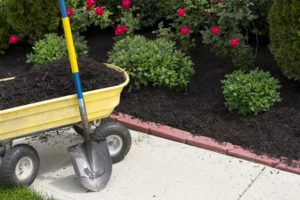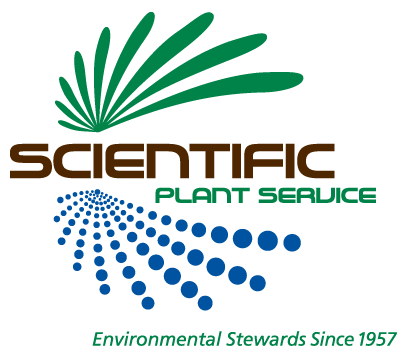
Mulching your garden bed should be included in your spring lawn care checklist.
Year-round lawn and landscape care can make your turf strong, green, and healthy. To practice good lawn and landscape care, you should pay special attention to your soil, as this is where your turf receives its nutrients and establishes healthy growth. When spring begins in just a couple of weeks, the season for gardening and increased lawn care will commence. You should prepare now for these spring lawn and landscape tasks, so you are ready for the taxing spring and summer seasons.
Spring Aeration
Aeration can increase the delivery of air, water, and nutrients to your grassroots. Ask a specialist at Scientific Plant Service whether your particular turf could benefit from aeration now, or whether you should wait. Often aeration and over-seeding are done at the same time to repair bare patches of turf. The frequency of aeration and over-seeding your lawn depends on which type of grasses make up your turf and the condition of your soil.
Mulch Garden and Flower Beds
Spring is a popular time of year to exercise your green thumb and plant new flowers in your garden beds. Your plants will benefit from the rainy spring weather, and your home will benefit from the beautiful arrangement of plants.
A spring lawn care and landscaping checklist that prioritizes mulching your garden beds will provide you with a healthy space for plants to grow. Mulch insulates plants from extremes of temperature and saves water from evaporating. To save as much water as possible and ensure a healthy landscape, you should maintain a two to three-inch layer of mulch and consider using a drip irrigation system. Be careful to keep mulch away from tree and shrub trunks. Mulch piled against tree trunks invites insect and disease problems.
Spring Cleanup Tasks
Your early spring lawn care checklist should include the removal of any lawn debris. This debris includes leaves, twigs, fallen branches, bark, and anything else that is covering your lawn. Lawn debris can harbor insects and fungus. In addition, lawn debris will damage your lawnmower blades. When clearing your lawn, make sure to:
- Rake the yard to remove all debris
- Remove dead branches
- Remove fallen leaves. Layers of wet leaves can smother a lawn if not removed.
Once you have cleared debris from your lawn, you can aerate and over-seed while applying any necessary fertilizer or herbicides to your turf. If you are over-seeding, take caution using any pre-emergent weed controls as they may interfere with the germination of the desirable seed.
Scientific Plant Service Is Your Go-To Source In Landscape Healthcare
Scientific Plant Service, located in Baltimore, is a privately owned corporation, chartered in Maryland in 1957 by Frank J. Burke. We started as a full-service Arborists specializing in the care of shade trees and ornamental shrubs, but today we are a Lawn Care company that is a huge part of the community. From aquatic environments and snow management to deer and mole control, SPS has services tailored specifically for your lawn and landscape.
We offer services in Maryland, Washington, DC, and Virginia, including: Harford, Baltimore, Carroll, Frederick, Howard, Anne Arundel, Montgomery, Prince Georges, Talbot, Queen Anne’s, Calvert counties in MD, as well as Loudoun County, Fairfax County, Arlington, Alexandria, and Falls Church in VA. For more information, contact us online, or call us at 410-321-0970. Be sure to follow us on Facebook, Twitter, LinkedIn, and Pinterest!

